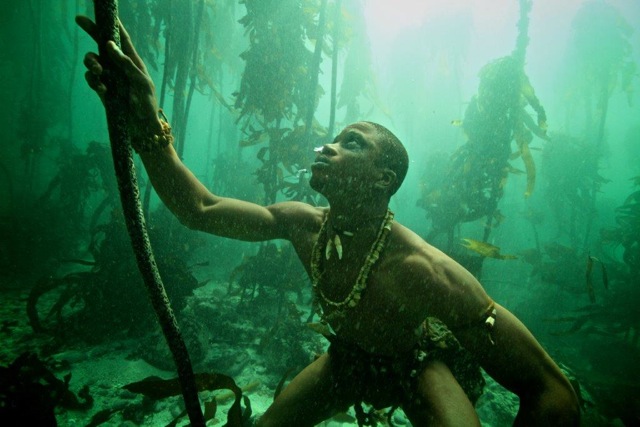The Sea-Change Exhibition of large format photographs along the sea wall on the Sea Point promenade tells the story of the evolutionary relationship all humans have with the ocean. In partnership with Wavescape, Pick & Pay, WWF-SASSI, ART54 and the Western Cape Government, the exhibition takes place from December 2014 to April 2015.
The latest scientific evidence shows that the first modern humans lived at the coast on the southern tip of Africa from around 200,000 years ago.
The archeological records at the “point of human origin” show the first evidence of cognitive human development, early nuclear family life, and human traits that we associate with modern humans today.
Starting at about 100,000 years ago, we see a big shift in human consciousness in the records that indicate knowledge of basic chemistry, jewellry and art. This leap in our evolution is arguably the greatest “sea-change” in the 200,000 year history of our species.
The phrase “sea-change” was first coined by Shakespeare in the play The Tempest, and it means a profound transformation wrought by nature.
It appears that this transformation was wrought in part by our relationship with the sea, as it is believed that the high nutrient content in seafood harvested from the abundant rocky shoreline and kelp forests fuelled the human brain and upgraded the architecture of our minds.
Because we all share the same ancestors, the southern tip of Africa is most likely the original home of everyone alive today.
The founders of Sea-Change, Ross Frylinck and Craig Foster, have been swimming and free diving in the pristine kelp forests around Cape Town for many years.
Foster says: “We’ve been attempting to re-encounter nature as we believe our ancestors did. On our journey we have slowly discovered a matrix of life that is astounding in its beauty and complexity. We have learnt to track underwater, we have found new species and behaviours, and we have had encounters with wild animals that we once thought was impossible. We have also learnt how the cold, nutrient-rich sea water positively affects our bodies and our minds.”
Frylinck suggests the best time to dive is in the early morning and late afternoon, when the sun is low in the sky.
This is when the kelp forest lights up and everything is radiant. Fish, sponges and anemones shine like living gems. For a while the forest becomes golden. Swimming and diving in this golden light can make you feel like an ‘oceanaut’ floating through an alien world. It’s wonderfully hypnotic. It’s also because of these experiences that we want to share our photos, videos and stories to inspire people to care for our marine heritage, and appreciate our unique human heritage.”
Sea-Change is a not-for-profit organisation mandated to promote marine conservation with a focus on Marine Protected Areas. The project is working in partnership with the Western Cape Government to assist in their application to have key archeological sites in the Western Cape pronounced a UNESCO World Heritage Site.
Entry to the exhibition is free, and by downloading the free Layar app onto your phone or tablet, you can watch related videos from the kelp forests.
For more information about Sea-Change please visit www.seachangeproject.com or email [email protected].
For more information about the 11th edition of the Wavescape Festival (from 29 November to 14 December), visit www.wavescapefestival.com



Наша набережная)))